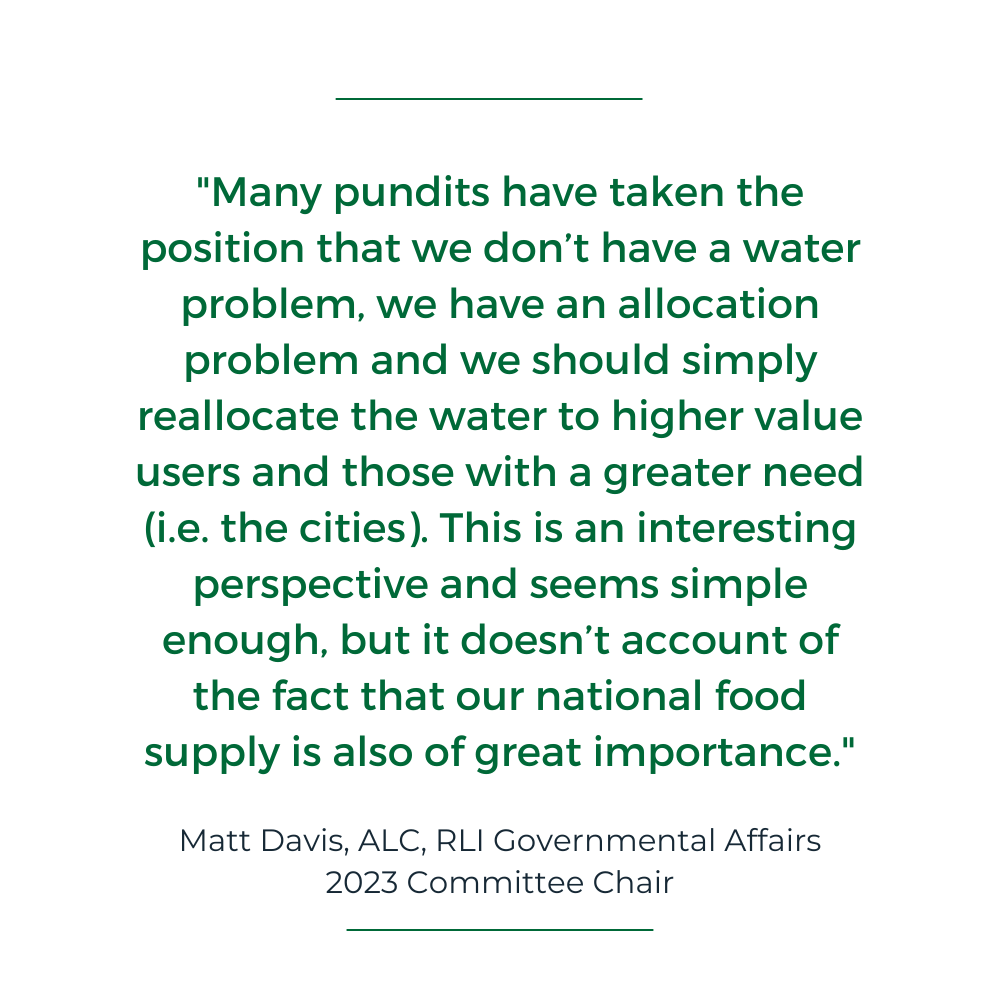By Matt Davis, ALC
The news has been filled with stories lately about the Colorado River being in crisis after more than 20 years of sustained drought. This year’s snowpack will help, but the problem remains, the river is overallocated. More water is drawn from the river each year than is flowing naturally which is reducing the reserves of Lake Mead and Lake Powell to critically low levels. These stories often reference that 80% of the water from the river is used for agriculture and 80% of the agriculture is “low value” forage crops, primarily alfalfa and Bermuda grass. The implication is that the water resources would be better used to support urban areas, specifically housing. When new housing is costly and in short supply, anything to help support further growth seems easy to get behind.
In addition to providing drinking water for 40 million people and supporting industry in the many southwest cities benefiting from its flow, the Colorado irrigates 5.5 million acres of agricultural land, which accounts for about 15% of all farmlands in the U.S. If the Colorado River basin were a country, it would be the 7th largest in the world in terms of economic output.
Who Owns the Water?
Ownership of water is regulated by each state and most states in the west follow the “Doctrine of Prior Appropriation”. Like mineral rights, water is part of the “bundle of rights” and is viewed as an asset that can be owned just like real estate. And like real estate, the government.png?ver=XT3LAsyczxu7SMRvlP_s4g%3d%3d) can’t take that right without fair compensation even if it is being reallocated to a more profitable use, or a more socially equitable one.
can’t take that right without fair compensation even if it is being reallocated to a more profitable use, or a more socially equitable one.
Western Water Law is based on this Doctrine of Prior Appropriation meaning the first to take the water from the river and put it to use, has the most senior water right. Anyone who takes water after the initial diversion, even if they are upstream, has a junior right.
Protecting the Nation’s Food Supply
Imperial Irrigation District, the district that serves Imperial County in southern California, is the largest water district in the nation. It receives about 20% of the total annual flow from the Colorado River watershed. IID manages 3,000 miles of gravity fed canals and drains and delivers water to over 520,000 irrigated acres ever year. With water rights dating back prior to 1902 Reclamation Law, IID’s rights have been determined by prior litigation to be “present perfected” and not subject to reclamation law limitations, meaning in times of shortage, these senior rights must be satisfied before junior rights holder’s allocations are satisfied.
 If you live in an urban area and are faced with your water rates continually increasing, all this water going to agriculture likely sounds like a waste. However, the “low value” forage feeds much of the nation’s livestock, providing us with a domestic source of nutrient dense protein and supporting a robust dairy industry. While much of the irrigated lands produce forage, the desert southwest specifically Imperial County, CA and Yuma County, AZ are known as the nation’s “winter salad bowl”. When most of the country is still wearing puffy jackets, many farmers in this region take advantage of the mild winter weather and get to work growing most of the mixed greens, carrots, and other fresh vegetables that the country enjoys this time of year.
If you live in an urban area and are faced with your water rates continually increasing, all this water going to agriculture likely sounds like a waste. However, the “low value” forage feeds much of the nation’s livestock, providing us with a domestic source of nutrient dense protein and supporting a robust dairy industry. While much of the irrigated lands produce forage, the desert southwest specifically Imperial County, CA and Yuma County, AZ are known as the nation’s “winter salad bowl”. When most of the country is still wearing puffy jackets, many farmers in this region take advantage of the mild winter weather and get to work growing most of the mixed greens, carrots, and other fresh vegetables that the country enjoys this time of year.
As alternatives, we could explore importing feed for our livestock and more beef, dairy, and produce from outside the country. Besides increasing costs for these staples in an already inflationary environment, produce and many other high value crops have a shorter shelf life, which limits the ability to import from the Southern Hemisphere without significant spoilage. In addition to cost making everyday items too expensive for some families to afford, the availability of those items is also of concern.
The fragility of the food supply chain and the importance of food security became evident during the pandemic and like manufacturing, we should now be looking for ways to bring our food supply closer to home, not reallocating the resources it needs to exist and outsourcing it further. It is time that we start to think of agriculture and the fresh, healthy nutrients it provides for us as a resource, and one that should be protected as aggressively as the resources we require such as the water we drink and the air we breathe.
Short-term Solutions
To find a solution that avoids unilateral action by the Bureau of Reclamation to protect the Colorado River System, the Lower basin States (Nevada, Arizona and California) reached agreement on collective reductions, some voluntary and some with compensation. This should be a step towards protecting both the Colorado River and our agricultural resources. This short-term solution covers reductions until 2026 when the current operating guidelines are set to expire and gives time for all stakeholders to establish new guidelines going forward from 2026. Hopefully, further solutions will continue to encourage farm conservation over fallowing, and voluntary compensated reductions rather than arbitrary reallocations. This is necessary to ensure that farms remain productive, farmers continue to be encouraged to make investments that conserve water and our agricultural industry remains vibrant and continues to be a year round reliable source of the nutrients we all need to thrive.
 Matt Davis, ALC is an Accredited Land Consultant (ALC) through the REALTORS Land Institute (RLI) and specializes in the sale of large complex land holdings and surplus land portfolios throughout North America. He is the platform leader of Cushman & Wakefield’s Land Advisory Group, a national team of land specialists that work across disciplines to provide creative solutions to clients with land assets, and the 2023 Chair for the RLI Governmental Affairs Committee.
Matt Davis, ALC is an Accredited Land Consultant (ALC) through the REALTORS Land Institute (RLI) and specializes in the sale of large complex land holdings and surplus land portfolios throughout North America. He is the platform leader of Cushman & Wakefield’s Land Advisory Group, a national team of land specialists that work across disciplines to provide creative solutions to clients with land assets, and the 2023 Chair for the RLI Governmental Affairs Committee.